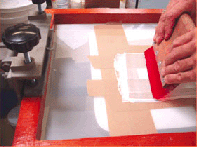Fabric Discoloration and How to Prevent it
April 26, 2018
Description
Fabric Discoloration, also known as "Ghosting" or "Bleaching", results from a reaction that takes place between ingredients used in some Lo-Bleed inks and some reactive dyes in 100% cotton garments. Yellow dyes seem to be the most troublesome.
Appearance
A faint, almost invisible, "ghost" image of the printed design is sometimes visible on the back side or inside of garments that have come in contact with a white ink print.
The Reaction
Three conditions need to be present for the discoloration to take place - heat, pressure and humidity. Take away any one of these three conditions and the reaction will not take place. The heat comes from the garments as they exit the dryer; pressure from stacking these hot garments as they exit the dryer; and humidity from moisture contained in the cotton garments.
The Solution(s)
- Use White inks formulated specifically for 100% cotton garments, or use a "non" lo-bleed white ink.
- Check to be sure that the inks you are using do not contain any bleaching agents (such as peroxide). International Coatings inks contain no bleaching agents. Some competitive brands do.
- Do not stack garments hot. Stagger stack - i.e., place them in several sequential stacks - and cool with a fan while stacking at the end of the dryer.
Test
To determine if your fabric is prone to ghosting, follow this simple test prior to production:
Equipment Needed:
Heat Transfer Machine set @ 200°F (93°C)
Test Procedure

1. Print the suspect fabric with the white ink you intend to use in production and fuse/cure normally.

2. Cover the printed area with another piece of the suspect fabric and mist VERY lightly with water.

3. Place the fabric set into the Transfer Machine, set @ 200°F (93°C), with minimal pressure (5 psi).

4. Close the machine and leave for up to 4 hours. Some fabric will discolor within 5 to 10 minutes. If the material is prone to "ghosting," you will see the "ghost" image on the un-printed fabric.


